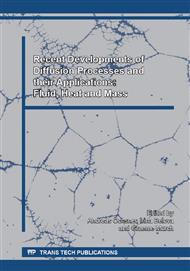p.1
p.9
p.18
p.27
p.35
p.44
p.61
p.71
Various Flow Regimes and Permeabilities for Packed-Spheres Porous Media
Abstract:
Flow in porous media occurs in many naturally-occurring and engineered systems. One of the key properties for understanding the fluid flow and pressure drop in porous media is permeability, which is varies widely among researchers. The current work presents systematic experimental data for packed spheres of uniform size (3 mm) having a porosity of 36.6% subjected to water flow. The experiments covered a sufficiently broad range of flow Reynolds number such that all flow regimes are encountered: pre-Darcy, Darcy, Forchheimer and Turbulent. The pre-Darcy regime is very scarce or non-present in the literature. As a necessary initial step, flow regimes were identified and different permeabilities exhibited by the porous medium in each flow regime were calculated. The length scales in defining the Reynolds number included the diameter of the sphere and the square root of the various permeabilities in order to study the transitional Reynolds numbers among the flow regimes. It is shown that the permeability in the Darcy regime is most appropriate and produces results consistent with accepted understanding in the literature of porous media.
Info:
Periodical:
Pages:
1-8
Citation:
Online since:
June 2015
Authors:
Keywords:
Price:
Сopyright:
© 2015 Trans Tech Publications Ltd. All Rights Reserved
Share:
Citation:


